Ultramarathon training plans for 100 miles, 100 Km, 50 miles and 50Km
Below are some selected ultramarathon training plans for various ultramarathon distances. I have not used any of these plans, but I have selected them on the basis of having a reasonable level of detail and some credibility.
| Plan | Distance | Max Long Run | Back To Back | Peak Weekly | Length (weeks) | Days/Week | Speedwork | Time/Distance | Level Of Detail | Notes |
|---|---|---|---|---|---|---|---|---|---|---|
| Relentless Forward Progress 100 miles on 50 MPW | 100 Miles | 50 miles | 24+14 miles | 58 miles | 24 | 5 | Yes | Distance | Complete book | See Below |
| Relentless Forward Progress 100 miles on 70 MPW | 100 Miles | 50 miles | 24+20 miles | 70 miles | 24 | 5 | Yes | Distance | Complete book | See Below |
| Ultraladies 100 Mile Plan | 100 Miles | 30 miles | 30+20 miles | 75 miles | 26 | 5 | No | Distance | Detailed plan giving daily runs | No details on paces for training runs, just distance |
| Umstead 100 Mile Plan | 100 Miles | 35-40 miles | No | 60-70 miles | 5 + 1 day speed walking | Suggested | N/A | Rough guide to each day of the week, but no weekly or daily details | Written for the Umstead 100, but some useful advice for other races. | |
| eRunningGuide.com 100 Mile Plan | 100 Mile | 30 miles | 25 + 30 miles | 73 miles | 24 | 3-4 | No | Distance | Detailed plan giving daily runs. | No details on paces for training runs, just distance |
| Hal Koerner's 100 Mile Plan | 100 Mile | 35 miles | 35 + 20 miles | 76 miles | 20 | 6 (including twice/day runs) | Tempo, Hills, Fartlek | Distance | Complete book | See below for caveats |
| Relentless Forward Progress 40 miles to 100K on 50 MPW | 40 miles to 100K | 31 miles | 18 + 10 miles | 51 miles | 24 | 5 | Yes | Distance | Complete book | See Below |
| Relentless Forward Progress 40 miles to 100K on 70 MPW | 40 miles to 100K | 31 miles | 25 + 12 miles | 69 miles | 24 | 5 | Yes | Distance | Complete book | See Below |
| Hal Koerner's 50 Mile to 100K Plan | 50 miles to 100K | 30 miles | 25 + 25 miles | 76 miles | 16 | 6 (including twice/day runs) | Tempo, Hills, Fartlek | Distance | Complete book | See below for caveats |
| Ultrarunning New Zealand 100Km Plan | 100 Km | 5 hours (45 Km/28 miles) | 4 hours+5 hours | 16 | 5 | Intervals + MP | Mixed | Detailed plan giving daily runs. | Specifies each run, with some indication pace, but no other advice. | |
| Ultraladies 50 Mile Plan | 50 Mile | 28 miles | 28 + 12 miles | 62 miles | 20 | 5 | No | Distance | Detailed plan giving daily runs. | No details on paces for training runs, just distance |
| Runner's World 50 Mile Plan | 50 Mile | 5 hours (27-29 miles) | 4 hours + 5 hours | 16 | 5 | Intervals + MP | Mixed | Detailed plan giving daily runs. | Some indication paces | |
| Relentless Forward Progress 50K on 50 MPW | 50K | 26 miles | 20 + 14 miles | 50 miles | 24 | 5 | Yes | Distance | Complete book | See Below |
| Relentless Forward Progress 50K on 70 MPW | 50K | 26 miles | 24 + 16 miles | 69 miles | 24 | 5 | Yes | Distance | Complete book | See Below |
| Competitor Magazines First 50K Plan (pdf) | 50 Km | 26 miles | 26 miles + 1 Hour | 16 | 5-6 | No | Mixed | Detailed plan giving daily runs. | Specifies each run, with some indication pace, but no other advice. | |
| Ultraladies 50K Plan | 50 Km | 26 miles | 26 + 10 miles | 56 miles | 20 | 5 | No | Distance | Detailed plan giving daily runs. | No details on paces for training runs, just distance |
| Hal Koerner's 50K Plan | 50K | 30 miles | 25 + 15 miles | 66 miles | 16 | 6 (including twice/day runs) | Tempo, Hills, Fartlek | Distance | Complete book | See below for caveats |
Contents
1 Notes
- Back to back. Many ultramarathon training schedules use two long runs on consecutive days, and this is the longest of those back to back pairs.
- Peek Weekly. This is the longest week, if specified.
- Day/week. How many days does the plan intend you to run.
- MPW. The number of Miles Per Week.
- Speedwork. What, if any, faster running is included in the plan. MP = marathon paced runs.
- Time/Distance. Does the plan specify the length of the run in terms of time or distance.
- Level Of Detail. Some plans will give each days run, specifying distance and pace, where others may only give a broad outline.
2 Ultramarathon and marathon plans compared
Marathon training plans have been around far longer than ultramarathon plans and are far better established. There are many books published on marathon training, with different approaches. By comparison, ultramarathon training plans are new and don't have the history. Therefore, don't expect that same quality of training plans for ultras that you might be used to from marathon training.
3 Relentless Forward Progress

Bryon Powell's book "Relentless Forward Progress", subtitled "a guide to running ultramarathons" is one of the first books that focuses on providing systematic advice on ultramarathon running. The book includes a number of training plans that are mentioned above, but also includes a lot of breadth and depth. While I may not agree with all of the advice, it's a well written book that is well worth reading interested in running ultramarathons. I particularly like the way that Bryon has asked many authors to write up sections of the book to give their perspective. I'm especially impressed the way Bryon gave two different authors the chance to put forward their opposing views on the role of speedwork in ultramarathon running. I think that Byron's book is worth reading, even if you don't use one of his plans. (Error: Could not parse data from Amazon!.)
4 Hal Koerner's Field Guide to Ultrarunning

Hal is an experienced, talented, and successful ultrarunner, having won many races. I had high hopes for Hal Koerner's Field Guide to Ultrarunning, and I think it does contain some useful advice and is worth a read. However, I feel that the book is based around Hal's personal experience which may not work for an average or novice ultrarunner. (Error: Could not parse data from Amazon!.)
- The depth of Hal's experience comes through in the book, but so does his lack of wider research.
- The advice to drink before you're thirsty and to drink beyond thirst is outdated and dangerous. While dehydration can slow you down, it really a serious problem, while over-hydration (Hyponatremia) can be fatal and has been for a number of runners. How does have a section on hyponatremia, but it's in a separate section of the book from hydration, and that the advice is unclear at best.
- Hal uses the Hill training sessions as High Intensity Interval Training which I think is an important part of any training program.
- Hal talks about descending, and gives plenty of advice on technique. (He ignores the critical aspect of Delayed Onset Muscle Soreness, but that's true of nearly every running book I've read.)
- It's nice to see that Hal mentioned Overtraining, but the advice is rather superficial.
- The advice to force yourself to eat when you're not hungry is something I believe to be a cardinal mistake. I have found that eating what appeals is a far more successful, and if nothing appeals, forcing food down rarely has a happy ending. I believe that our subconscious and appetite has a far more sophisticated ability to determine what we need.
- Recommending that gels are always taken with water ignores The Science of Energy Gels.
The book does contain three training plans, for the 50K, 50 miles to 100K, and 100 miles. These plans feel a little like an afterthought, tucked in the back of the book almost like an appendix. The plans that do include fartlek, hill repeats, and tempo runs but the details seem lacking. Hal mentions that the tempo run should be at 10K pace, but does not indicate how much of the 6-20 mile tempo run should be at that 10K pace. The 50 K plan includes a 30 mile long run, which seems a little excessive, as does the 25+15 back to back long runs.
5 Other Ultrarunning Books
There are a number of books that are worth considering, even though they don't contain training plans.
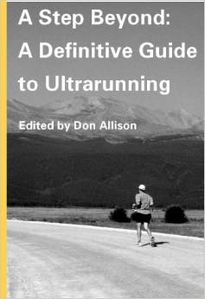 A Step Beyond: A Definitive Guide to Ultrarunning is a little old now as it was published in 2004, but it contains a wealth of useful information. The book is a collection of individual chapters, each written by a different author, so it can be a little disjointed. While I don't agree with all of the advice, it's a worthwhile investment. |
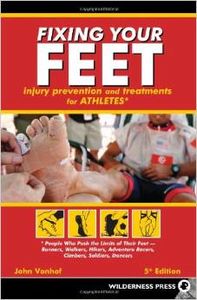 If you've read my guide to Blister Prevention and Taping your feet to prevent or treat blisters and you still want to know more, then Fixing Your Feet is the definitive book on the topic. Error: Could not parse data from Amazon! |
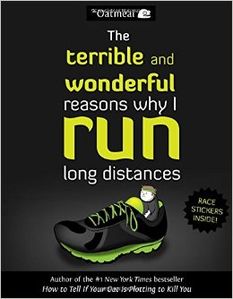 This is a comic book on running by The Oatmeal, and it's a great read. Of course, humor is a personal thing, so check out the online comic to get a taste of the book. Error: Could not parse data from Amazon!. |
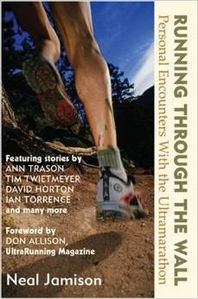 Running Through the Wall: Personal Encounters with the Ultramarathon is just that; it's individual runners experiences with ultrarunning. Not a huge source of information, but an entertaining read in places. Error: Could not parse data from Amazon!. |
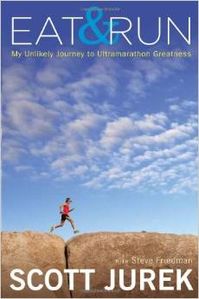 Eat and Run: My Unlikely Journey to Ultramarathon Greatness is part autobiography, part recipe book from the elite ultrarunner Scott Jurek. I found it fascinating to read about Scott's life, and why he runs ultras, and he does include several bits of ultrarunning advice. Error: Could not parse data from Amazon!. |
 Another autobiography from a top ultrarunner, Ultramarathon Man: Confessions of an All-Night Runner is a fairly easy read, though I found it provided less insight than "eat and run". Error: Could not parse data from Amazon!. |
 This may seem like an old entry in the list of books ultrarunning, but I believe that The Old Man and The Sea provides greater inspiration and insight into the ultrarunning psyche than most books dedicated to the topic. Error: Could not parse data from Amazon!. |
6 See Also
- A brief guide to ultramarathon distances
- Essential Ultrarunning Tips
- Fixing problems in Ultramarathons
- Training for your first 100 mile race
- Your First 100 Mile Race
- The Morton Stretch to refresh legs mid-race
- Sleep Deprivation in Overnight Events
- Walking Breaks
- Fueling in an Ultra
- Aid Stations
- Drop Bags
- Crewing an Ultra